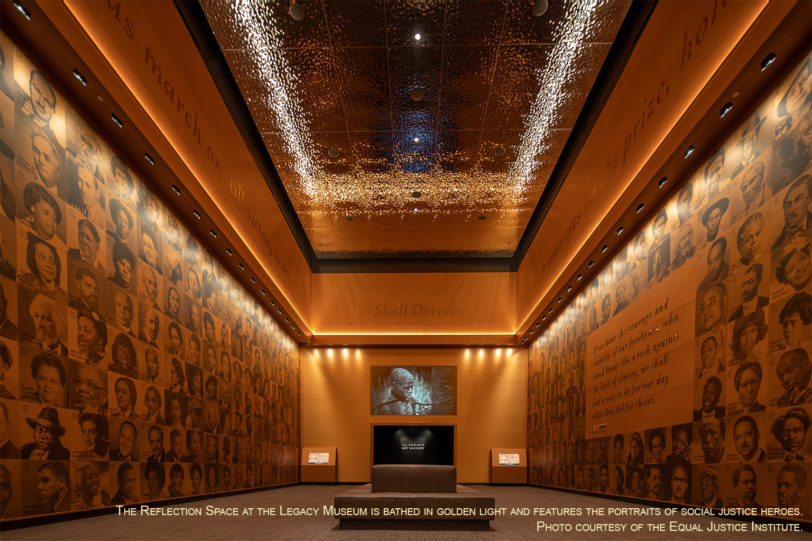This story, reported by Sasha Rogelberg, originally appeared on Feb. 15, 2023, in the Philadelphia Jewish Exponent. Subscribe here.

Last October, a minyan of Jews of African descent traveled to Montgomery, Alabama, with the Wyncote-based Reconstructing Judaism. Specifically for Black Jews across the country, the Reconstructing Judaism pilgrimage is believed to be the first trip of its kind.
Though the trip was months ago, the impact among participants is palpable.
“It was really powerful, not just to be able to engage with other Jews of African descent, but to be able to do so while being held in a Jewish framework,” said Amanda Beckenstein Mbuvi, Reconstructing Judaism’s vice president for academic affairs, of the pilgrimage. “That really made tangible for me the commitment of Reconstructionist Judaism to really receive people of color as Jews and as whole people.”
The pilgrimage is part of Reconstructing Judaism’s intention to build community for Black Jews both within the organization and in the greater Jewish community. On Feb. 9, the Weitzman National Museum of American Jewish History hosted “Deconstructing Racism to Reconstruct Judaism: The Story of a Pilgrimage Down South,” a panel outlining the event’s significance.

The pilgrimage was a way to consider the experiences of Black Jews in the greater Jewish American context, particularly looking at the relationship between healing, teshuvah and anti-Black racism. Calling the trip a pilgrimage draws on the Jewish tradition of pilgrimage for Pesach, Sukkot and Shavuot, according to Koach Baruch Frazier, a Reconstructionist Rabbinical College student and Tikkun Olam Commission representative who co-organized the trip.
“In the Torah, it says that you must go, so that you can be seen and, some say, so that you can be seen by God and that you see God,” Frazier said. “… What does it mean to show up and see God in Black people?”
During the pilgrimage, participants visited the National Memorial for Peace and Justice and Legacy Museum: From Enslavement to Mass Incarceration, as well as met with civil rights activist Joanne Bland, who took part in the “Bloody Sunday” march.
For participants, the pilgrimage was an opportunity to explore the depth of both grief in the American legacy of racism and celebration in Black resilience. Without white counterparts, participants felt they were able to bring their identities to the experience without inhibition.
In the Torah, it says that you must go, so that you can be seen and, some say, so that you can be seen by God and that you see God.
Koach Baruch Frazier Tweet
“It was so nice to be in a place where you didn’t have to explain your Judaism, your Jewishness,” said Wilbur Bryant II, a Kol Tzedek member who attended the pilgrimage.
“As Black people in this country, we have to go about our day not being angry, outwardly being angry, about what’s been done to us and what is still being done to us,” he said.
On the pilgrimage, Bryant continued, “I didn’t have to smile if I didn’t want to, like we have to do in our everyday lives, because, you know, God forbid someone thinks we’re angry.”
The purpose of the all-Black and Jewish pilgrimage was to provide an opportunity for participants to feel present and whole, without having to be privy to the potential guilt and judgment of white Jews on the trip grappling with their complicity in racism, according to Rabbi Micah Weiss, Reconstructing Judaism’s assistant director for thriving communities and tikkun olam specialist.
“We want people to have as much sholem, and wholeness, in space with many lines of difference,” he said. “But the more that we can access our whole selves in particular spaces, it empowers us to bring as much of our full, healthy, as-healed-as-possible selves to group spaces across lines of difference.”

Reconstructing Judaism is planning another pilgrimage from March 16-19 open to Jews of any race. The March pilgrimage is another piece of Reconstructing Judaism’s efforts to think critically about Jewish identities.
“We’ve been doing a lot of work as a community, thinking about engaging with accessibility, engaging with class, and a lot of different ways of really thinking about identities and experiences that are often marginalized,” Mbuvi said, “Not only to make our own community more inclusive, but also to really think about how we can really see and receive and respond to the full diversity of experiences that people are bringing to Jewish community.”

Outside of pilgrimages, Black Jews are looking to connect in Philadelphia, experiencing delight in both finding similarities in ancestral narratives and differences in Jewish practices. Frazier attends a monthly “Black Folks Shabbat” and is looking to build relationships with Black Jewish communities in the Greater Philadelphia area, such as Congregation Temple Beth’El in North Philadelphia.
“I make it my duty to be around all Black folks, all Black, Jewish folks to continue that joy and that exuberation and that experience of being with my kin,” they said







